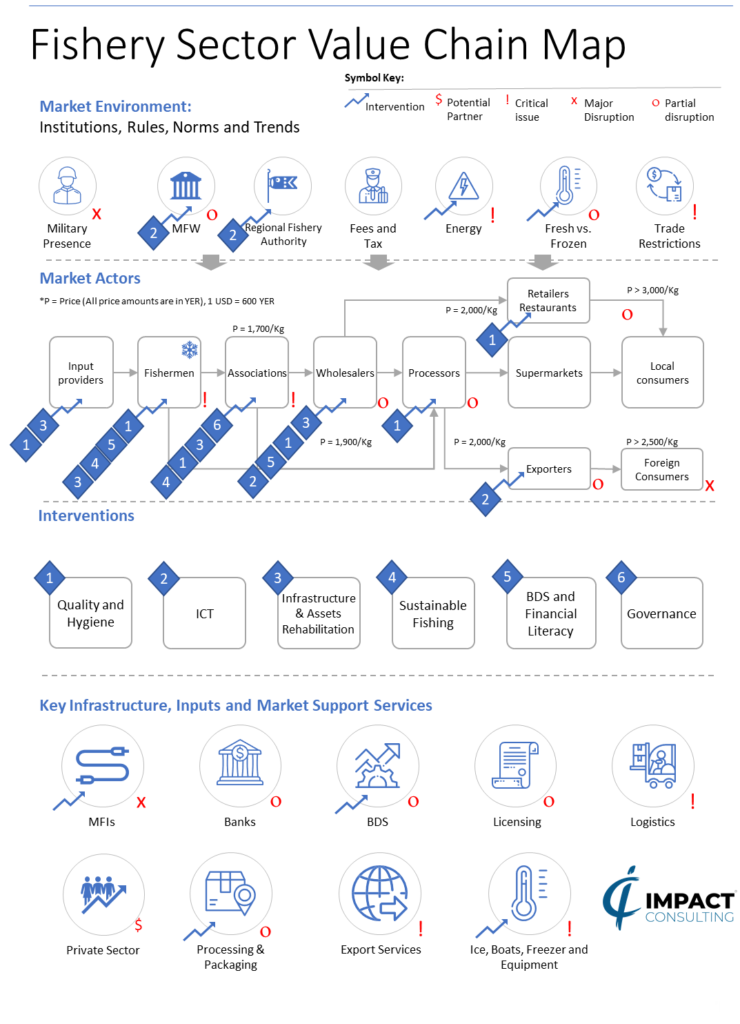The fishing industry in Yemen was ranked the third sector in Yemen. However, the once flourishing fisheries sector in Yemen has been devastated by the war. Small-scale fishermen households have lost their livelihoods. Fishing boats have been destroyed and fishermen killed, many fisher households have been internally displaced. Landing sites and auction yards has been damaged. The once so important export market is now to a large extent off limits.

Around 90% of the fishermen are engaged in small-scale artisanal fishing. The major challenge facing fishermen is the large increase in the cost of supplies, particularly fuel. These cost increases are further exacerbated by the decrease of income for fishers as a result of the armed conflict.
A main challenge in the entire fishery value chain is the deficient cold chain. Fishers can easily lose their entire income from a fishing trip due to lack of cold chain. They don’t have quality cooling boxes onboard to keep the catch in, they lack access to ice at landing sites.
The fishing industry in Yemen suffers from major infrastructure issues such as rudimentary and small-capacity landing sites and fish processing facilities, which also often suffer from poor management. The lack of adequate landing sites, a general lack of cold storage facilities and limited access to affordable power generation has been made worse by the ongoing conflict.Financial support to fishers would greatly help develop production. A top priority for artisanal fishers is new boats, fully equipped with fishing gear, including coolers. Entrepreneurs in the fishery industry lack access to finance needed for their plans to expand business.
Needs for training of fishermen and fishery associations have been identified as sustainable fishing skills, hygienic fish handling, understanding the marine environment and fish ecological diversity, etc. Processors need training on quality control and best international fish processing practices. Local authorities need capacity development around quality control, administration, planning and inspections.
Fishery cooperatives and associations play multiple roles, including the authority to take care of auctioning at the landing sites. Fishers and fishery associations maintain close relationships with each other, but many fishermen are today unwilling to pay their fees to associations as they cannot see that the associations have provided anything of much value since the onset of the current conflict in 2015.
The entire fishery value chain is bulk supply driven, with little attention being paid to consumer satisfaction and preferences. Fishing methods are not sustainable, with apparent risks for overfishing of some species. The fisheries sector has long suffered from ineffective management and weak enforcement of regulations by the Ministry of Fish Wealth and Fisheries Regional Authorities.
However, Yemen has one of the richest marine ecosystems in the world. A trend of increasing domestic and global demand for fish offers stable market circumstances. Investments in improved fish quality and value-addition across the value chain are needed and destroyed infrastructure needs to be replaced. The fisheries sector undoubtedly has the potential to continue providing employment and means of livelihood for Yemen’s coastal population. This includes opportunities also for women, who have so far played a very marginal role in the fisheries sector.
The fishing industry in Yemen has been identified as one of the most promising sectors with potential to contribute to pro-poor economic growth and socio-economic development in Yemen, with employment for poor people and diversification of the economy.
However, since the outbreak of the armed conflict in 2015, Yemen has not until recently signed or renewed any international aid or donor agreements for the fisheries sector. Five previous large Government fishery projects over the period 1973-2015 were funded by the World Bank, co-financed by the European Union, UNDP, the Government of Yemen and a few other donors. Through these five projects, investments were made in cold store facilities, the construction of a fishery harbour, an artisanal fishing port and a fish processing facility, facilities for fish handling at landing sites, intermediate technology fishing vessels, a fleet of insulated and refrigerated trucks, etc. Artisanal fishermen were trained and given credit facilities for the purchase of traditional fishing vessels. Support was given to fishing cooperatives, fish marketing and research on fish stock, and Government personnel were trained in management, quality control, fishery research, fish landing regulation, etc.
A sixth project, the Fish Investment Project (2011-2016) was a USD 30.9 million investment implemented by the International Fund for Agricultural Development. Its aim was to improve the economic status of artisanal fisher households to create sustainable economic opportunities for fishermen communities in the project areas. The project worked on reducing illegal and destructive fishing methods. It also strengthened fishermen’s organizations and their ability to deliver services for their members.
In the past two years, UNDP, USAID, FAO and the European Union have provided funding aimed at restoring fishing based-livelihoods by rehabilitating fishery sector facilities, providing solar powered cold storage at landing sites and coolers on fishing boats, distribution of fishing boats, engines, fishing nets and GPS, building entrepreneurial skills to improve business, providing training on fiberglass boat maintenance, outboard engine maintenance and repair.
Further, women, whose participation in fisheries is almost negligible, have been engaged in local fishing businesses focused on converting fish waste into fertilizers, salt production and packaging, fish farming, sale of dry fish, fishing equipment stores and maintenance of fishing equipment.
Against this backdrop, the need has been felt for a study to review the current actual state of the fishery sector in Yemen in 2022, its weaknesses, gaps and opportunities, and with an assessment of its current and prospective value added to the country’s economy and trade, and the livelihoods of coastal communities in Yemen.
Purchase the full report $999.99
Yemen Fishing Exports

Fishery Value Chain Map

Fishery expert, apply here
Fisheries Value Chain Actors in Yemen
Opportunities and disruptions across value chain actors in the fishing industry in Yemen.

Yemen’s fishing industry faces critical challenges in accessing ice, cold storage, and energy. The sector overall opportunity is to improve and ensure quality, this includes infrastructure facilities such as landing sites and services to fishers to assure quality. The sector has been interrupted due to the war with safety and security challenges, lack of regulations and enforcement, poor governmental control, policies, and services, as well as trade restrictions.
References
- Alabsi, Natheer and Teruhisa Komatsu. Characterization of fisheries management in Yemen: A case study of a developing country’s management regime, Marine Policy, Volume 50, 2014
- Al-Fareh, Ammar Mohammed. The Impact of the War in Yemen on Artisanal Fishing of the Red Sea. Monograph. London School of Economics Middle East Centre, December 2018. http://www.lse.ac.uk/Middle-East-Centre
- Bonfiglioli, Angelo and Khaled Hariri. Small-Scale Fisheries in Yemen: Social Assessment and Development Prospects. FAO, World Bank, 2004. https://documents1.worldbank.org/curated/en/603351468168235834/pdf/404440YE0Fisheries01PUBLIC1.pdf
- Cusack, M. et al. Organic carbon sequestration and storage in vegetated coastal habitats along the western coast of the Arabian Gulf. Environmental Research Letters, April 2018
- Elayah, Moosa et al. Fishing during War? – The Impact of War on Yemeni Fisheries. Center for Governance and Peace-building, 2018
- FAO. Yemen – Shocks, Agricultural Livelihoods and Food Security. December 2021. https://doi.org/10.4060/cb7844en.
- Kumar, Arun et al. Distribution of Mangroves along the Red Sea Coast of the Arabian Peninsula: Part-3: Coast of Yemen. April 2011
- Ministry of Fish Wealth supported by UNDP and IFAD. National Fisheries Strategy 2012-2025
- Murray, Brian et al. Potential for Protecting Threatened Coastal Habitats. Policy Brief, Nicholas institute, Duke University, 2010
- Nagi, Hisham et al. Estimating Total Area of Mangrove Habitats in The Republic Of Yemen Using Remote Sensing and GIS. Faculty of Science Bulletin, Volume 24 Sana’a University, October 2012
- Sana’a Center for Strategic Studies. Rethinking Yemen’s Economy. Developing Yemen’s Fishing Industry. April 2020 https://devchampions.org/publications/policy-brief/Developing_Yemens_Fishing/
- SMEPS and Royal Tropical Institute (KIT) Netherlands, for the World Bank. Analysis of 5 Value Chains – Yemen (Fish, Honey, Coffee, Wheat and Qat). 2009 https://www.fao.org/sustainable-food-value-chains/library/details/en/c/243929/
- Suha, Mohammed. How War Destroyed Yemen’s Once-Thriving Fishing Industry. New Lines Magazine (blog), February 2021. https://newlinesmag.com/reportage/how-war-destroyed-yemens-once-thriving-fishing-industry/
- UNDP. Fishery Value Chain – A Market Study, 2020. https://www.ye.undp.org/content/yemen/en/home/library/fishery-value-chain—market-study.html
- UNOCHA. Humanitarian Needs Overview Yemen. 2021 https://reliefweb.int/report/yemen/yemen-humanitarian-needs-overview-2021-february-2021-enar
- UN Women. Women’s Economic Empowerment in Fisheries in the Blue Economy of the Indian Ocean Rim. 2020. https://www.unwomen.org/sites/default/files/Headquarters/Attachments/Sections/Library/Publications/2020/Womens-economic-empowerment-in-fisheries-in-the-blue-economy-of-the-Indian-Ocean-Rim-en.pdf
- USAID. The Fisheries Sector in Yemen, Status and Opportunities. 2019. https://pdf.usaid.gov/pdf_docs/PA00WFZJ.pdf
- USAID. Economic Recovery & Livelihoods Program (ERLP) – Yemen. Quarterly Report, 2020. https://pdf.usaid.gov/pdf_docs/PA00XVSB.pdf
- World Bank. Fisheries Sector Strategy Note. 1999.
- World Bank, Implementation Completion and Results Report, Fisheries Resource Management and Conservation Project. 2014.
